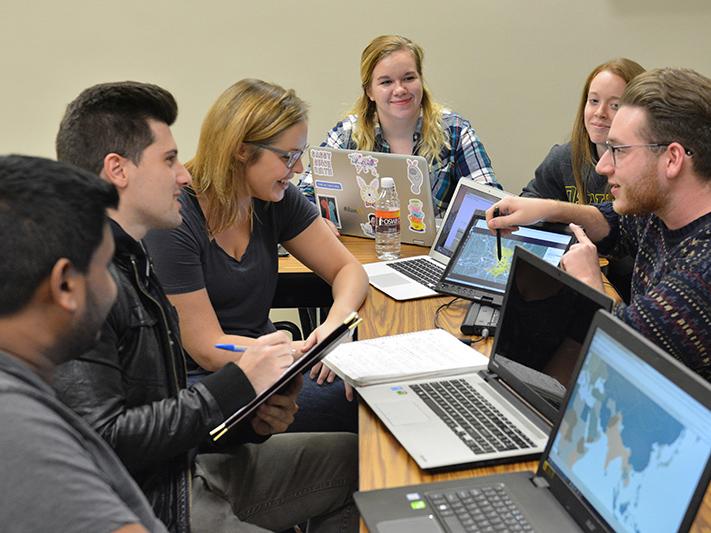Arts and sciences -- Seniors in history faculty member Murat Yasar’s “Seminar: Empires in Eurasia” class in Room 212 of Mahar Hall use ArcGIS software to visualize data, a tool serving one of the many kinds of digitally innovative projects anticipated by the Humanities Collaboratory, under way with extensive planning across campus and launching formally in fall 2018. Clockwise from lower left are mathematics and German major Salman Kabir, history majors Brian Emanuele and Helena Kaszluga, adolescence education majors with social studies concentrations Diana Dalaba and Caitlin Mazzeo, and German and history major Michael Kaefer.
Satellite imagery, 3D modeling, data-visualization maps: At SUNY Oswego, the tools of technology and the sciences are moving traditional humanities -- history, philosophy, literature and languages -- forward.
Software usability, the ethics of technology, awareness of multicultural scientific advances: At the college, the values and thinking of the humanities are infusing the sciences and arts.
Set to formally launch in fall 2018, a project led by the College of Liberal Arts and Sciences brings new scale to the notion of "applied humanities" by building the Humanities Collaboratory, a web of bridges interconnecting academic disciplines, skillsets and resources.
Project lead Adrienne McCormick, dean of the College of Liberal Arts and Sciences, said, "Our primary goals are twofold: We want students to be able to see and articulate how their humanities skillsets intersect with other fields and can be applied in a variety of contexts, and we want to enable faculty to pursue increased interdisciplinary collaborations in research and teaching that bridge the humanities to STEM, the arts and social sciences fields of inquiry."
History faculty member Murat Yasar shares an example. He uses -- and has taught students to use -- ArcGIS software, a location-based tool for data visualization, to literally map his research.
"I am reading primary sources of the Ottoman Empire on migrations from the North Caucasus -- settlement records, taxation records, and so on," Yasar said. "Once those sources are read, databases will be created to visualize the data mined from the Ottoman Archives. I will put the data on a GIS map, which will help me and the students I train ask questions of the data that need answering."
'Raising awareness'
While not a new concept nationally or on campus, collaborative projects in applied humanities -- when extended across the schools and departments of the college -- will bring new visibility and energy to this effort, whose goals are closely aligned with those set out in the college's "Tomorrow" strategic plan, McCormick said.
"The departments we've traditionally associated with the humanities -- this project is not compartmentalized there," she said. "We're really looking at raising awareness of the connections humanities have to and across so many areas of campus."
The 2016-17 Smart Neighbors project with Oswego's Man in the Moon Candies, conceived by English and creative writing faculty member Leigh Wilson, can be seen as a precursor for the Humanities Collaboratory and offers a vivid example of what applied humanities look like: Faculty and students from classes in management, poetry, sculpture, photography, sociology and more worked on marketing ideas for the chocolatier, infusing each discipline's skillsets and perspectives.
David Vampola, a computer science faculty member and coordinator of the college's new cross-disciplinary minor in digital humanities, co-leads a working group for the Humanities Collaboratory with Penfield Library Director Sarah Weisman.
The group has identified a need for two labs and a digital repository, corresponding to what Vampola dubbed the three Cs -- curriculum, creation and curation. The first would provide a space and workstations where faculty across disciplines could teach students to use state-of-the-art software as well as try pedagogical methods such as team teaching.
The second, an innovation lab, would provide a home for students' faculty-supported project collaboration and creation. And the repository would serve as a place to store, consult, reuse or revise the scholarly products of the Collaboratory: web pages, GIS maps, multimedia presentations and more.
Next generation
"An important aspect of this is involving faculty at an early stage of their careers," Vampola said. Among his colleagues on the working group are early-career faculty members Yasar, Candis Haak in history, Fiona Coll in English and creative writing, Lindsay Bell in anthropology, Caglar Yildirim in the human-computer interaction graduate program and Serenity Sutherland in communication studies. Faculty members Ulises Mejias in communication studies and Lisa Glidden in political science are also contributing to this effort.
Haak -- who is working with 3D modeling, satellite imagery and GIS software on a project for "examining the people you don't see in history texts" in medieval landscapes in South Asia -- said the Humanities Collaboratory is "creating the next generation of scholars."
Yasar added, "And also the next generation of teachers. This is not just a project for our research. Oswego is, at the end of the day, a teaching college. We are teacher-scholars. We want to give our students the edge they need in the job market."
Patricia Clark, associate dean for liberal arts and sciences as well as leader of the Humanities Collaboratory effort, agreed there's plenty of room in the sciences, including computer science, for the skillsets that humanities graduates can bring to bear.
"If you think about the changing face of the workplace and how technical skills are needed in every profession, I think it's really valuable to have humanists at the forefront in terms of asking the good hard ethical questions about the human uses of technology and the implications of certain technologies," Clark said.
McCormick added, "The future of work is team-based, it's mobile, it's problem solving, it's exciting. We can't know what those future careers are going to look like or how the future workforce will be deployed. Yet you want modular skills that you can take and apply in a variety of different contexts. That's the kind of packaging together of different skillsets that we want to promote with the Humanities Collaboratory."




